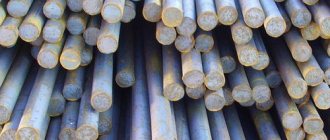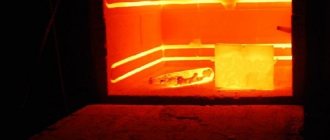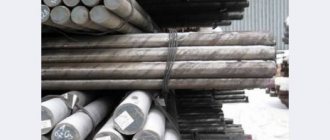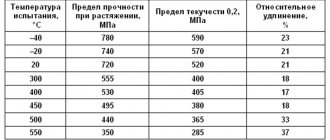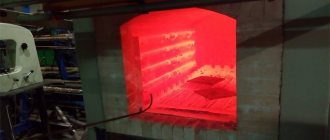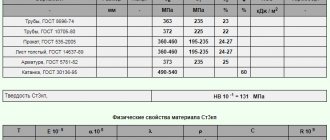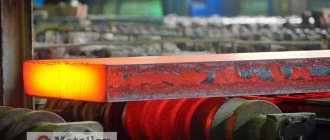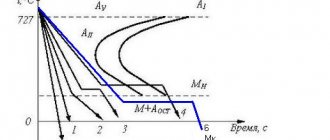Hardening of steel 45 is carried out in order to increase the hardness, wear resistance and strength characteristics of the surface of workpieces and parts.
It is a type of heat treatment, with the help of which they are given the necessary performance properties. In terms of carbon content, structural steel 45 (0.45% C) is classified as medium carbon, which makes machining and weldability difficult.
Such steel is used for the manufacture of structures and devices that withstand loads. The metal has good strength and wear resistance, and is not susceptible to corrosion processes during operation.
Hardening improves these indicators, which determines the areas of application of steel 45. Shafts, cylinders, spindles, cams and other parts of machines and mechanisms of mechanical engineering, agricultural, construction and other equipment are made from it, as well as pliers, vices and other tools and devices used in industry and everyday life.
Effect of heat treatment on quality
Steel in its original state is a fairly plastic mass and can be processed by deformation.
It can be forged, stamped, rolled. To change the mechanical properties and achieve the required qualities, heat treatment of the metal is used. The essence of thermal or heat treatment is the use of a set of operations for heating, holding and cooling hard metal alloys. As a result of such processing, the alloy changes its internal structure and acquires certain properties necessary for the manufacturer and consumer.
Critical points
Critical points are temperatures at which the structure of steel and its phase state change. Calculated in 1868 by the Russian metallurgist and inventor Dmitry Konstantinovich Chernov, therefore they are sometimes called Chernov points.
Such points are designated by the letter A. The lower point A1 corresponds to the temperature at which austenite turns into pearlite when cooled or pearlite into austenite when heated. Point A3 is the upper critical point, corresponding to the temperature at which ferrite begins to separate during cooling or its dissolution ends when heated.
If the critical point is determined during heating, then the index “c” is added to the letter “A”, and when cooling, the index “r” is added.
For this steel, the following critical point temperatures are determined:
- 743*C - Ac1;
- 815*C - Ac3;
- 730*C - Ar3;
- 693*C - Ar1.
Algorithm for heat treatment of steel and alloys:
- annealing:
- hardening;
- vacation;
- normalization;
- aging;
- cryogenic treatment.
Heat treatment for 40x steel. Characteristics of the temperature regime in accordance with the requirements of GOST 4543–71:
- hardening of steel 40x in an oil environment at a temperature of 860*C;
- tempering in water or oil at a temperature of 500*C.
As a result of this heat treatment, this steel acquires increased hardness (HB hardness number no more than 217), high tensile strength (980 N/m2) and impact strength of 59 J/cm2.
Yield strength
Speaking about mechanical properties, it is necessary to mention such an important characteristic as the yield strength. If the applied load is too great, then the structure or its parts begin to deform and not elastic (completely disappearing, reversible), but plastic (irreversible residual) deformations appear in the metal
In other words, the metal “flows.”
The yield point is the boundary between elastic and elastoplastic deformations. The value of the yield strength depends on many factors: heat treatment mode, the presence of impurities and alloying elements in the steel, microstructure and type of crystal lattice, temperature.
In metallurgy, a distinction is made between the concepts of physical and conditional yield strength.
The physical yield strength is the stress value at which the deformation of the test specimen increases without increasing the applied load. In reference books, this value is designated σt and for grade 40x its value is no less than 785 N/mm2 or 80 KGS/mm2.
It should be noted that plastic (irreversible) deformations do not appear in the metal instantly, but increase gradually, with increasing applied load. Therefore, from a technology point of view, it is more appropriate to use the term “conditional (technical) yield strength.”
The conditional (or technical) yield strength is the stress at which the prototype receives a plastic (irreversible) elongation of its calculated length by 0.2%. In the tables this value is designated as σ 0.2 and for steel 40x it is:
- at temperatures from 101 to 200*C - 490 MPa;
- at temperatures from 201 to 300*C - 440 MPa;
- at temperatures from 301 to 500*C - 345 MPa.
How to harden 45 steel at home
The word “heat treatment” is not new to ordinary people. Everyone understands perfectly well why it is needed. Increasing the strength of steel. But why does this happen? What processes are occurring in the metal at this moment? Most shrug their shoulders. If you want to understand what heat treatment is, find out the difference between annealing and tempering, and why 45 steel is hardened in oil and not in water, then this article is for you.
General information about heat treatment
Heat treatment is a sequence of heating, holding and cooling processes aimed at changing the mechanical properties of steel.
Improvements in the properties of the metal occur due to the transformation of the internal structure. After heat treatment, steel can be in 2 states: stable and unstable.
The steady state is characterized by the complete completion of all ongoing processes in the steel. Unstable, on the contrary, is when the steel is still affected by factors that interfere with the stabilization of internal stresses. A striking example is the chemical heterogeneity of hardened steel.
An increase in the thermal movement of molecules helps to accelerate the recovery of steel from an unstable state. This is achieved by heating.
To better understand the processes occurring in steel during heat treatment, let us introduce several concepts about the structure of the metal. This refers to the size of the internal grains and their position relative to each other. Each structure corresponds to a certain temperature and a certain carbon content.
Their main types and properties they have:
- Ferrite is a solid solution of iron with carbon and a small proportion of other chemical elements. Ferromagnetic. Ferritic steel has high thermal and electrical conductivity. Plastic. Hardness is about 70-140 units on the Brinell scale.
- Cementite is an unstable compound of carbon and iron. Very hard and brittle (HB 790-810). Cannot be magnetized.
- Perlite is a phase solution of ferrite and cementite. Its mechanical properties are primarily influenced by the distance between the phases. The closer they are, the stronger the steel. Hardness is in the range of 160-230 HB, with a relative elongation of 9-12%.
- Martensite is a supersaturated physicochemical mixture of carbon and iron. The value of its mechanical characteristics depends on the amount of carbon in the composition. Martensitic steel with a concentration of 0.2% C has a hardness of about 35 HRC. At 0.6% the hardness is 60 HRC.
- Austenite is a solid solution of carbon in iron. Austenitic steel is paramagnetic and ductile. The relative elongation is 42%.
The heat treatment process itself includes:
- Hardening.
- Annealing.
- Normalization.
- Vacation.
Annealing
The annealing process consists of heating, holding and slow cooling in a furnace environment.
There are two main varieties of it:
- Annealing of the first kind, in which the structure of the steel does not undergo changes.
- Annealing of the second kind, accompanied by transformations of structural zones.
Each of the presented types of heat treatment has a specific purpose.
First type annealing performs the following technological tasks:
- Leveling the chemical composition of steel. When metal is processed by pressure, segregation causes the formation of fractures and microcracks. To reduce their likelihood of occurrence, steel is heated to 1250 ºС and kept at this temperature for 8-15 hours.
- Increasing the machinability of steel by pressure. Heat treatment takes place at 670 ºС with a holding time of 40-120 minutes. Annealing increases ferrite grains, which has a positive effect on ductility.
- Reduction of residual stresses arising after technological processing of steels: cutting, welding, etc. To do this, the steel is kept at 500-620 ºС for two hours.
Second-order annealing refines the steel grains and promotes the formation of a ferrite + pearlite structure. As a result, there is an increase in mechanical properties. The heating temperature for steel 45 is 780-830 ºС.
Annealing of the second type is considered a preparatory heat treatment. It is carried out before cutting operations to increase the machinability of the metal.
Normalization
This is the process of heating steel and subsequent cooling in air, as a result of which the coarse-grained structure is refined.
Compared with annealing, normalization gives an average of 10% higher viscosity and strength. The reason for this lies in air cooling, which promotes the decomposition of austenite phases in the lower temperature zone. As a consequence, an increase in perlite is observed, which is the reason for the increase in mechanical properties.
Normalization is an alternative to hardening and high tempering. Of course, the resulting mechanical properties are lower, but the normalization itself is less labor-intensive. In addition, compared to hardening, it causes less thermal deformation of the part.
Vacation
This is a heat treatment that is always carried out at the final stage. It involves heating hardened steel to the temperature point where pearlite transforms into austenite and then cooling it further. With its help, the mechanical characteristics of steels are brought to the required values.
In addition, the task of tempering is to relieve the stresses remaining after hardening.
Vacation is divided into 3 types according to heating temperature:
- Low vacation. It is carried out at 230-260 ºС. Promotes strengthening while simultaneously reducing internal tension. Hardened steel 45 after low tempering has a hardness of 55-60 HRC.
- Average vacation. Heating temperature 340-550 ºС. Allows you to achieve the highest value of elastic properties. Because of this, it is mainly used in the manufacture of springs. Hardness is at the level of 45-52 HRC.
- High holiday. Performed at 550 ºС. Relieves internal stress after hardening.
Mechanical properties decrease, but their value is no less than after normalization and annealing. There is also an increase in impact strength. The most optimal heat treatment from the point of view of the ratio of viscosity and strength is considered to be hardening the steel, and then conducting a high tempering.
Hardening
It is a heating process to a temperature 20-40 ºС above the dissolution point of ferrite in austenite and subsequent rapid cooling in water or oil.
The formation of significant internal stresses during hardening does not allow it to be the final heat treatment. It is usually followed by a vacation or normalization.
As a result of heating, the steel acquires an austenitic structure, which, upon cooling, transforms into fine-needle martensite.
Hardening of steel 45 is carried out at 840-860 ºС.
If steel is hardened before reaching the required temperature, the result will be ferritic zones, whose presence significantly reduces the strength of the metal.
If 45 steel is hardened at temperatures above 1000 ºC, this will provoke an increase in the martensite grain, which entails a deterioration in toughness and an increased risk of cracking.
Heating of steels for hardening is carried out in periodic or continuous electric furnaces.
Heating time depends on:
- Chemical composition of steel.
- Shapes and dimensions of parts.
The larger the size and carbon content, the longer the amount of time required to heat the steel.
After heating the steel, it is held at a given temperature. This is necessary to level out the inhomogeneity of austenite.
When severely overheated, the steel begins to react with furnace gases. This can lead to oxidation and decarbonization processes.
Oxidation is the chemical process of interaction of oxygen with iron. It negatively affects the properties of steel and causes a decrease in surface quality and scale.
Decarbonization occurs as a consequence of the chemical reaction of carbon with hydrogen and oxygen. As a result, forming compounds such as carbon monoxide and methane. The resulting gases carry away carbon molecules from the surface of the steel, thereby causing a sharp decrease in strength.
Heat treatment of steel 45
Thermal treatment
of steel 45
, as well as heat treatment of any other grade of steel, is carried out to improve the technical characteristics of this material.
This treatment involves initial heating of the metal and its subsequent cooling. Actually, depending on the heating time of the material and the cooling rate, heat treatment of steel 45
and other grades is divided into 3 sequential operations:
- Annealing steel 45
- Hardening steel 45
- Steel tempering 45
Annealing steel 45
- this is heating the material in a special furnace to a very high temperature and its subsequent cooling, which is carried out naturally, that is, together with the furnace. There is first-order annealing, in which heating reaches critical values, but does not exceed them. There is also annealing of the second kind, in which the temperature already exceeds a critical level and leads to some changes in the structure.
One way or another, any of these methods allows you to get rid of the heterogeneity of the composition, as well as relieve the internal stress of the material and achieve a granular structure. In addition, annealing 45 steel will help reduce the hardness of the alloy, which will greatly facilitate the further processing process. It is noteworthy that annealing of the second type is divided into the following several categories, differing in their purpose and execution:
- diffusion annealing
- full annealing
- partial annealing
- isothermal annealing
- recrystallization
Typically, full annealing is used for carbon steels. The essence of this technology is that the workpieces are heated to a temperature that exceeds the critical point (upper point Ac3) by approximately +30°C to +50°C. After this, steel 45 is cooled at a slow rate from +150°C to +200°C until its temperature is equal to the temperature value in the operating range from +500°C to +550°C.
By the way, during annealing of the first and second types, the material is cooled in the furnace in which the heating was carried out. If the cooling process is already carried out in the open air, then this technology will not be called annealing of steel 45, but normalization. Since cooling occurs faster when steel is normalized, pearlite acquires a thin structure and the greatest hardness. Therefore, normalized steel is harder than annealed steel.
Steel structure 45
Thus, cementite is a chemical compound Fe3C, and besides it, ferrite (C) is also present in steel. Together they form another structure - perlite. Since the carbon content is below 0.8%, such steel is considered hypoeutectoid. And in order to improve its properties, it must be hardened or annealed. This is achieved by heating it, during which it passes into the austenitic state. Critical points for this alloy: AC1=725 °C, AC3=770°C. When heated to 700°C, no noticeable changes will occur.
Let's look at the state diagram of steel 45 in more detail.
So, since the alloy contains 0.45% carbon, on the lower horizontal line, it is necessary to find this value. Climbing up from it, you can follow all the transformations in steel. So, when heated above the AC line, the alloy will be in a liquid state.
Then, as the temperature decreases, the atomic lattice of iron will be rearranged from face-centered to body-centered and, accordingly, ferrite will predominate in it. A large amount of carbon will gradually transform from austenite to pearlite. The final structure of the alloy will also depend on how the steel was cooled after quenching.
Main characteristics of steel 45
Any alloy has its own distinctive characteristics, a certain chemical composition, a number of substitutes, and a functional purpose.
Grades 40, 45, 50 are distinguished by their high strength levels, while having low viscosity and ductility. Since the mechanical properties of grade and 45 are identical to grades 40 and 50, these steels are interchangeable.
Chemical composition and properties
The chemical components of the alloy, in addition to iron and carbon, are a number of other elements, the amount of which is insignificant. The percentage of chemical components of steel 45:
- Iron (Fe) - about 97%.
- Carbon (C) - 0.42-0.5%.
- Manganese (Mn) - 0.5-0.8%.
- Silicon (Si) - 0.17-0.37%.
- Nickel (Ni) - no more than 0.25%.
- Chromium (Cr) - no more than 0.25%.
- Copper (Cu) - no more than 0.25%.
- Arsenic (As) - no more than 0.08%.
- Sulfur (S) - no more than 0.04%.
- Phosphorus (P) - no more than 0.035%.
Its chemical properties directly depend on the chemical composition of steel and its structure.
All elements included in the composition are conventionally divided into useful and harmful. The process of adding useful impurities is called doping. If you decipher the 45x marking, it becomes clear that the alloy contains the addition of chromium, 45 g of manganese. Basic chemical properties of the material:
- oxidation state:
- corrosion resistance;
- heat resistance;
- heat resistance.
Mechanical characteristics
To analyze and control the properties of steel, various methods for determining them are used. For example, the criteria for strength and ductility are determined experimentally, and the samples are stretched until they break. The hardness of alloys is determined by measuring the resistance of the material when a hard element, for example, a diamond tip, is applied to its surface. Viscosity - impact tests of special samples.
Mechanical properties and characteristics of steel 45 (at t=20C).
Strength is the ability of an alloy to withstand external loads without being damaged internally. Characterized by the following values: tensile strength, sв and yield strength of steel 45, sT.
- pipe - GOST 8731–87, sв =588 MPa, sT =323 MPa;
- rolled products - GOST 1050–88, sв=600 MPa, sT =355 MPa;
- annealed rolled steel - GOST 1050–88, sв =540 MPa.
Hardness is the ability of an alloy to resist when exposed to solid bodies. Characterized by the following values: hardness according to N.V. Brinell 10-1, according to Rockwell HRC. For grade 45 as delivered:
- pipe - GOST 8731–87, HB 10–1 = 207 MPa;
- rolled products - GOST 1050–88, HB 10–1 = 229 MPa;
- annealed rolled steel - GOST 1050–88, HB 10–1 = 207 MPa.
Plasticity is the ability of an alloy to change its shape under the influence of a load and restore it after the end of the impact. Characterized by the value, relative elongation at break, δ5:
- pipe - GOST 8731–87, δ5 =14%;
- rolled products - GOST 1050–88, δ5 =16%;
- annealed rolled stock - GOST 1050–88 - δ5 =13%.
Impact strength is the ability of a material to resist the dynamic effects of load, KCU [kJ/m2].
Physical properties
The physical characteristics of steel include: density, coefficient of thermal expansion, thermal conductivity, modulus of elasticity, specific heat and electrical conductivity.
Metal alloys have high density, heat capacity and electrical conductivity. Let's consider the physical properties of grade 45 (at t=20C).
Density or specific gravity is the mass of a substance per unit volume, the density of steel is 45 GOST 1050–88 ρ=7826–7595 kg/m3.
The coefficient of linear thermal expansion is quantitatively equal to the relative change in the linear dimensions of a substance with an increase (decrease) in temperature in the alloy by 1 degree Celsius, α (1/deg).
Thermal conductivity of a substance is the ability to transfer an amount of heat from a more heated area to a less heated one. It is characterized by the value of the thermal conductivity coefficient, λ [W/(m deg)].
Young's modulus is a physical quantity that indirectly reflects the ability of steel to resist longitudinal deformations (tension or compression)
This value indicates the rigidity of the material and is an important physical feature, E 10-5 = 2 MPa;. Specific heat capacity - the amount of heat required to heat 1 kilogram of a substance by 1 degree Celsius, Ϲ [J/(kg deg)
Specific heat capacity is the amount of heat required to heat 1 kilogram of a substance by 1 degree Celsius, Ϲ [J/(kg deg).
Electrical conductivity is the ability of a material to be a conductor of electric current. It is characterized by the value of electrical resistivity, Ṛ.
https://www.youtube.com/watch?v=qbg1nU99OBYhttps://www.youtube.com/watch?v=L3w8hfcBXW8
Hardening steel 45
The word “heat treatment” is not new to ordinary people. Everyone understands perfectly well why it is needed. Increasing the strength of steel. But why does this happen? What processes are occurring in the metal at this moment? Most shrug their shoulders. If you want to understand what heat treatment is, find out the difference between annealing and tempering, and why 45 steel is hardened in oil and not in water, then this article is for you.
Advantages and disadvantages
Hardening of parts using HDTV has both advantages and disadvantages. The advantages include the following:
- After high-frequency quenching, the part retains a soft center, which significantly increases its resistance to plastic deformation.
- The cost-effectiveness of the process of hardening HDTV parts is due to the fact that only the surface or zone that needs to be hardened is heated, and not the entire part.
- During mass production of parts, it is necessary to set up the process and then it will be automatically repeated, ensuring the required quality of hardening.
- The ability to accurately calculate and adjust the depth of the hardened layer.
- The continuous-sequential hardening method allows the use of low-power equipment.
- A short heating and holding time at high temperature contributes to the absence of oxidation, decarburization of the top layer and the formation of scale on the surface of the part.
- Rapid heating and cooling does not result in large warpage and distortion, which allows for a reduction in finishing allowance.
https://youtube.com/watch?v=IjuKarv04Ec
But it is economically feasible to use induction installations only for mass production, and for single production, purchasing or manufacturing an inductor is unprofitable. For some parts with complex shapes, induction production is very difficult or impossible to obtain a uniform hardened layer. In such cases, other types of surface hardening are used, for example, gas-flame or volumetric hardening.
Features of high-frequency current hardening technology
Heating is carried out in an installation called induction.
It consists of a high-frequency generator and an inductor of simple or complex shape. The part to be hardened can be installed in the inductor itself or near it. Alternating current passing through the inductor causes the occurrence of eddy currents (Foucault currents), due to which the workpiece surface quickly heats up.
By changing the current parameters, you can adjust the depth of heating of the workpiece, and therefore the strength. The surface hardness ranges from 58÷62 HRC, while the core remains softer. Such indicators cannot be achieved by heating in a furnace, since it will be carried out throughout the entire volume.
Immediately after hardening, steel 45 is subject to the next stage of heat treatment - normalization or tempering.
The hardening process of high-frequency steel 45 is shown in the video:
The hardening mode can be simultaneous or sequential. This depends on the size of the part to be hardened. The first case is used for small-sized parts, the second - for large-sized ones.
physical characteristics
Almost all physical properties of metals depend directly or inversely on temperature. Indicators such as resistivity, coefficient of linear expansion and specific heat capacity increase with increasing temperature, while the density of steel, its modulus of elasticity and thermal conductivity, on the contrary, decrease with increasing temperature.
Another physical characteristic, called mass, does not depend on practically anything. The sample can be subjected to heat treatment, cooled, processed, given different shapes, and the mass will remain unchanged.
The physical characteristics of all known grades of domestic steels and alloys, including the grade described, are summarized in tables and placed in reference books on metal science.
Carbon and its effect on the properties of steel
One of the most important components that strengthens this alloy and gives it hardness is carbon. In addition, it reduces plasticity and viscosity. The effect of carbon on the characteristics of steel 45 is clearly visible in the phase diagram. Its properties will depend on the structure of the alloy. For example, with a pearlite structure, steel is easier to process and weld. The ferrite structure is characterized by low hardness and high ductility. Austenite in steels is always liquid and when it is cooled, the position of carbon grains in the crystal lattice can change significantly.
Recommendations when choosing
65g steel cannot be welded at all. When manufacturing products, this property should be taken into account.
You also need to remember that the material is most often used for sports edged weapons. This is due to good impact resistance at the simultaneous low cost of the starting material. This allows you to have shells available at low material costs.
Knife made of 65G steel.
Knives made from 65g are not recommended for use for household purposes, for example, in the kitchen, where there is constant dampness. To prevent cutting tools made from this grade from rusting, they must be stored in dry rooms. The oil coating will protect the blades from corrosion.
Why harden?
Recently, hardening is increasingly carried out in order to increase the hardness of the surface to increase the service life of the part. If the hardening was carried out correctly, its result will be:
- Strength and hardness are significantly increased. To ensure that the surface of the gear tooth does not deform under load, the procedure in question is performed. Also, springs and springs can withstand heavy loads due to a significant increase in strength by changing the structure during strong heating and rapid cooling of the material.
- The wear resistance of the surface increases. Despite the good performance qualities of steel, when it is used for the manufacture of parts used in mechanical engineering and aircraft construction, there is a possibility of rapid wear due to the frictional force upon contact. The service life of parts can be significantly increased by changing the initial structure of the metal.
- Modern methods of carrying out the process under consideration make it possible to improve the quality of only the surface of the part; the core, its viscosity, remains unchanged. This point determines that strength, hardness and wear resistance increase without the appearance of fragility, that is, the resulting part also has good ductility and can withstand longitudinal load.
The quality of the hardening performed depends on the heating rate and the correct choice of temperature, holding time and cooling. In this case, the most important parameter is the heating temperature and cooling rate, since they determine the hardness and strength of the metal. Hardening is a complex technological process, the implementation of which requires special equipment and certain skills in carrying out such work.
Physical properties
As mentioned earlier, the characteristics of the alloy as a whole will depend on the hardening of steel 45. Ferrite itself is soft and quite ductile, while pearlite is hard, but more brittle. So, the perlite structure looks like puff pastry. Crystals of soft ferrite alternate with hard cementite. The latter give pearlite wear resistance and hardness. Based on this, we can conclude that as the carbon content increases, the volume occupied by pearlite also increases and, of course, the properties of the alloy improve.
In general terms, we can say that 45 steel is quite strong, durable and easy to machine. Disadvantages include poor weldability and susceptibility to corrosion. Parts made of steel 45 are resistant to wear and can withstand temperature changes from 200 to 600 °C. More details about the physical and mechanical properties can be seen in the following table.
As with any other steel, before machining it is necessary to calculate the cutting conditions. In them, it is necessary to select the correct cutting tool, spindle rotation speed and, of course, calculate the feed. Despite the fact that steel 45 lends itself well to machining, if cutting modes are chosen incorrectly, problems such as too hot, flying chips, and an arbitrary decrease in spindle speed are possible. In addition, for this type of machining such as turning, it is recommended to use a coolant for this alloy.
The choice of cutting tool is also of great importance. It must be selected according to steel hardness 45. For example, the T15K6 cutter and others with similar properties are perfect.
